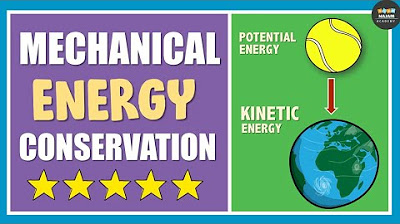Mechanical Energy Grade 10
Summary
TLDRIn this engaging lesson on mechanical energy, the instructor explains the two primary types of energy: potential energy, which depends on an object's height, and kinetic energy, related to its velocity. Using a roller coaster as a relatable example, the concepts are illustrated through calculations, showing how potential and kinetic energies change while the total mechanical energy remains constant due to the law of conservation. The session concludes with practical problems, reinforcing the understanding that as one form of energy decreases, the other increases, ensuring the total energy remains the same throughout the motion.
Takeaways
- 😀 Mechanical energy is the sum of potential energy and kinetic energy.
- 🏔️ Potential energy depends on the height of an object above a reference point.
- 🚀 Kinetic energy is related to the speed of an object and is calculated using its mass and velocity.
- 🎢 A roller coaster demonstrates the transformation between potential and kinetic energy as it moves.
- ⚖️ The law of conservation of mechanical energy states that in a frictionless system, total mechanical energy remains constant.
- 📊 Students can calculate potential and kinetic energy using specific formulas.
- 🔄 Understanding energy transformation is crucial for analyzing physical systems.
- 📉 Energy is lost to friction in real-world scenarios, affecting the total mechanical energy.
- 🔬 The concepts of energy are foundational in physics and are applicable in various real-life contexts.
- 📚 Knowledge of mechanical energy prepares students for more advanced topics in physics and engineering.
Q & A
What is mechanical energy?
-Mechanical energy is the total energy of an object, calculated as the sum of its potential energy and kinetic energy.
What are the two types of energy discussed in the lesson?
-The two types of energy discussed are potential energy, which is energy due to height, and kinetic energy, which is energy due to motion or velocity.
How is potential energy calculated?
-Potential energy is calculated using the formula PE = mgh, where m is mass, g is the acceleration due to gravity (9.8 m/s²), and h is the height above a reference point.
What is the formula for kinetic energy?
-The formula for kinetic energy is KE = 0.5mv², where m is mass and v is velocity.
What happens to potential and kinetic energy as the roller coaster descends?
-As the roller coaster descends, its potential energy decreases while its kinetic energy increases, but the total mechanical energy remains constant.
What is the law of conservation of mechanical energy?
-The law of conservation of mechanical energy states that in the absence of non-conservative forces (like friction or air resistance), the total mechanical energy of an object remains constant throughout its motion.
What is the significance of the reference point when calculating potential energy?
-The reference point is crucial for calculating potential energy because it determines the height (h) from which the potential energy is derived.
How can you determine the mechanical energy at different points in a system?
-You can determine the mechanical energy at different points in a system by ensuring that the sum of potential and kinetic energy remains the same, according to the law of conservation of mechanical energy.
What is the relationship between height and potential energy?
-The relationship is direct; as height increases, potential energy increases, and as height decreases, potential energy decreases.
In the example provided, what is the mechanical energy of the roller coaster at different points?
-In the example, the mechanical energy of the roller coaster is consistent at 102,500 joules at all points, assuming no external forces are acting on it.
Outlines

Cette section est réservée aux utilisateurs payants. Améliorez votre compte pour accéder à cette section.
Améliorer maintenantMindmap

Cette section est réservée aux utilisateurs payants. Améliorez votre compte pour accéder à cette section.
Améliorer maintenantKeywords

Cette section est réservée aux utilisateurs payants. Améliorez votre compte pour accéder à cette section.
Améliorer maintenantHighlights

Cette section est réservée aux utilisateurs payants. Améliorez votre compte pour accéder à cette section.
Améliorer maintenantTranscripts

Cette section est réservée aux utilisateurs payants. Améliorez votre compte pour accéder à cette section.
Améliorer maintenantVoir Plus de Vidéos Connexes

Belajar IPA - Energi Kinetik, Potensial dan Mekanik Kelas 7 SMP/MTs #Energi #energikinetik

The Difference Between Kinetic and Potential Energy

Work Power and Energy by Science Matters for Grade 8 Science

Conservation of Mechanical Energy | Physics

What is Energy in Physics | Energy Definition | Types of Energy Class 11 | SimplyInfo

Introduction to Conservation of Mechanical Energy with Demonstrations
5.0 / 5 (0 votes)
